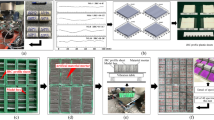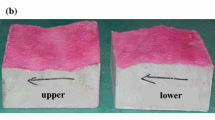Abstract
Joint surface morphology has essential implications for joint shear behaviors. In this paper, constant normal load (CNL) direct shear tests were performed on 150 artificial rock joint specimens to study the joint surface degradation process under various initial joint roughness coefficient (JRCinitial), joint wall compressive strength (JCS), and normal stress (σn) values. The experimental results revealed that with increases in JRCinitial, JCS, and σn, the joint surface exhibited different levels of increased degradation. With increasing shear displacement, the JRC continued to decline and finally tended to stabilize to a constant value, and we divided the degradation process into an initial weakening phase, a rapid weakening phase, and a constant weakening phase. Based on regression analyses, a JRC degradation model was presented to evaluate the JRC values of rock joints under various displacements, and a new empirical equation was introduced to predict peak shear displacement. Additionally, a piecewise function for the different shear displacement stages was proposed to calculate JRCmobilized by replacing JRC in the JRC–JCS model, and the variation in the friction angle \(\phi\) at various stages was discussed. Finally, a modified constitutive model was developed to predict shear strength versus displacement curves. The predicted results indicated that the new proposed model performs better than previous models.











Similar content being viewed by others
References
Amadei B, Saeb S (1990) Constitutive models of rock joints. In: International symposium on rock joints. A.A. Balkema, Leon
Amadei B, Wibowo J, Sture S et al (1998) Applicability of existing models to predict the behavior of replicas of natural fractures of welded tuff under different boundary conditions. Geotech Geol Eng 16(2):79–128
Amiri Hossaini K, Babanouri N, Karimi Nasab S (2014) The influence of asperity deformability on the mechanical behavior of rock joints. Int J Rock Mech Min Sci 70:154–161
Asadi MS, Rasouli V, Barla G (2013) A laboratory shear cell used for simulation of shear strength and asperity degradation of rough rock fractures. Rock Mech Rock Eng 46(4):683–699
Asadollahi P, Tonon F (2010) Constitutive model for rock fractures: revisiting Barton's empirical model. Eng Geol 113(1):11–32
Asadollahi P, Invernizzi MCA, Addotto S, Tonon F (2010) Experimental validation of modified Barton’s model for rock fractures. Rock Mech Rock Eng 43(5):597–613
Aydan O, Ichikawa Y, Ebisu S, Komura S, Watanabe A (1990) Studies on interfaces and discontinuities and an incremental elasto-plastic constitutive law. In: International symposium on rock joints. A.A. Balkema, Leon, Norway
Babanouri N, Karimi Nasab S (2015) Modeling spatial structure of rock fracture surfaces before and after shear test: a method for estimating morphology of damaged zones. Rock Mech Rock Eng 48(3):1051–1065
Bahaaddini M, Hagan PC, Mitra R, Khosravi MH (2016) Experimental and numerical study of asperity degradation in the direct shear test. Eng Geol 204:41–52
Bandis S (1980) Experimental studies of scale effects on shear strength and deformation of rock joints, PhD thesis, University of Leeds, p 385
Bandis S, Lumsden AC, Barton NR (1981) Experimental studies of scale effects on the shear behaviour of rock joints. Int J Rock Mech Mining Sci Geomech Abstr 18(1):1–21
Barton N (1973) Review of a new shear strength criterion for rock joints. Eng Geol 7:287–332
Barton N (1982) Modelling rock joint behavior from in situ block tests: implications for nuclear waste repository design. In: Office of Nuclear Waste Isolation, Columbus, OH, p 96, ONWI-308, September 1982
Barton N, Choubey V (1977) The shear strength of rock joints in theory and practice. Rock Mech 10(1–2):1–54
Belem T, Souley M, Homand F (2009) Method for quantification of wear of sheared joint walls based on surface morphology. Rock Mech Rock Eng 42(6):883–910
Ferrero AM, Migliazza M, Tebaldi G (2010) Development of a new experimental apparatus for the study of the mechanical behaviour of a rock discontinuity under monotonic and cyclic loads. Rock Mech Rock Eng 43(6):685–695
Goodman RE (1976) Methods of geological engineering in discontinuous rock. West, New York
Grasselli G, Egger P (2003) Constitutive law for the shear strength of rock joints based on three-dimensional surface parameters. Int J Rock Mech Min Sci 40(1):25–40
Gui Y, Xia C, Ding W et al (2017) A new method for 3D modeling of joint surface degradation and void space evolution under normal and shear loads. Rock Mech Rock Eng 50(10):2827–2836
Homand F, Belem T, Souley M (2001) Friction and degradation of rock joint surfaces under shear loads. Int J Numer Anal Meth Geomech 25(10):973–999
Hong ES, Kwon TH, Song KI et al (2016) Observation of the degradation characteristics and scale of unevenness on three-dimensional artificial rock joint surfaces subjected to shear. Rock Mech Rock Eng 49(1):3–17
Huang TH, Chang CS, Chao CY (2002) Experimental and mathematical modeling for fracture of rock joint with regular asperities. Eng Fract Mech 69(17):1977–1996
Indraratna B, Thirukumaran S, Brown ET, Premadasa W, Gale W (2014) A technique for three-dimensional characterisation of asperity deformation on the surface of sheared rock joints. Int J Rock Mech Min Sci 70:483–495
Jacobsson L (2004) Oskarshamn site investigation—boreholes KLX02 and KLX04A—uniaxial compression test of intact rock and normal loading and shear tests on joints. Svensk Kärnbränslehantering AB
Jing L (1990) Numerical modeling of jointed rock masses by distinct element method for two and three-dimensional problems. Lulea University of Technology, Lulea
Karami A, Stead D (2008) Asperity degradation and damage in the direct shear test: a hybrid fem/dem approach. Rock Mech Rock Eng 41(2):229–266
Kulatilake PHSW, Fiedler R, Panda BB (1997) Box fractal dimension as a measure of statistical homogeneity of jointed rock masses. Eng Geol 48(3–4):217–229
Kwafniewski MA, Wang JA (1997) Surface roughness evolution and mechanical behavior of rock joints under shear. Int J Rock Mech Min Sci 34(3–4):157.e1–157.e14
Ladanyi B, Archambault G (1969) Simulation of the shear behaviour of a jointed rock mass. In: The 11th symposium on rock mechanics, Berkeley, pp 105–125
Lee HS, Park YJ, Cho TF et al (2001) Influence of asperity degradation on the mechanical behavior of rough rock joints under cyclic shear loading. Int J Rock Mech Min Sci 38(7):967–980
Maksimović M (1992) New description of the shear strength for rock joints. Rock Mech Rock Eng 25(4):275–284
Odling NE (1994) Natural fracture profiles, fractal dimension and joint roughness coefficients. Rock Mech Rock Eng 27(3):135–153
Park JW, Song JJ (2009) Numerical simulation of a direct shear test on a rock joint using a bonded-particle model. Int J Rock Mech Min Sci 46(8):1315–1328
Patton FD (1966) Multiple modes of shear failure in rock. In: The 1st congress of the International Society of Rock Mechanics, Lisbon, pp 509–513
Plesha ME (1987) Constitutive models for rock discontinuities with dilatancy and surface degradation. Int J Um Anal Methods Geomech 11:345–362
Szirte T, Green S (1998) Applied dimensional analysis and modeling. Appl Dimens Anal Model 25(3):637
Tatone BSA, Grasselli G (2010) A new 2D discontinuity roughness parameter and its correlation with JRC. Int J Rock Mech Mining Sci 47(8):1391–1400
Tse R, Cruden DM (1979) Estimating joint roughness coefficients. Int J Rock Mech Mining Sci Geomech Abstr 16(5):303–307
Van Sint Jan ML (1990) Shear tests of model rock joints under stiff normal loading. In: International symposium on rock joints. A.A. Balkema, Leon, Norway
Wibowo J (1994) Effect of boundary conditions and surface damage on the shear behavior of rock joints: tests and analytical predictions. University of Colorado, Boulder
Xia CC, Tang ZC, Xiao WM, Song YL (2014) New peak shear strength criterion of rock joints based on quantified surface description. Rock Mech Rock Eng 47(2):387–400
Yang ZY, Lo SC, Di CC (2001) Reassessing the joint roughness coefficient (JRC) estimation using Z2. Rock Mech Rock Eng 34(3):243–251
Yu X, Vayssade B (1991) Joint profiles and their roughness parameters. Int J Rock Mech Mining Sci Geomech Abstr 28(4):333–336
Zhao J (1997) Joint surface matching and shear strength part B: JRC–JMC shear strength criterion. Int J Rock Mech Min Sci 34(2):179–185
Acknowledgements
This study was funded by the National Natural Science Foundation of China (41602293). We appreciate the valuable comments and suggestions from the anonymous reviewers, which helped us improve the manuscript.
Author information
Authors and Affiliations
Corresponding author
Additional information
Publisher's Note
Springer Nature remains neutral with regard to jurisdictional claims in published maps and institutional affiliations.
Rights and permissions
About this article
Cite this article
He, L., Zhao, Z., Chen, J. et al. Empirical Shear Strength Criterion for Rock Joints Based on Joint Surface Degradation Characteristics During Shearing. Rock Mech Rock Eng 53, 3609–3624 (2020). https://doi.org/10.1007/s00603-020-02120-4
Received:
Accepted:
Published:
Issue Date:
DOI: https://doi.org/10.1007/s00603-020-02120-4




